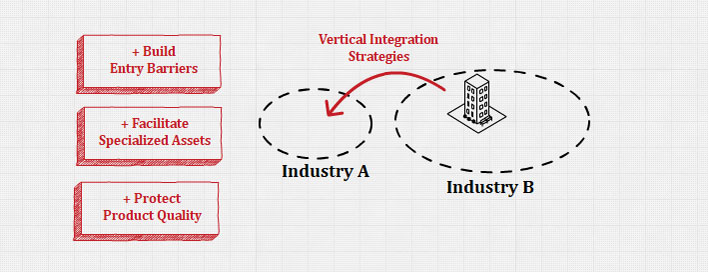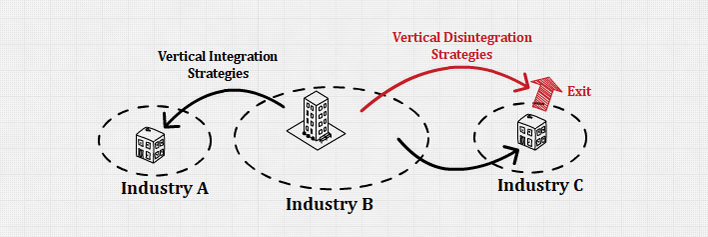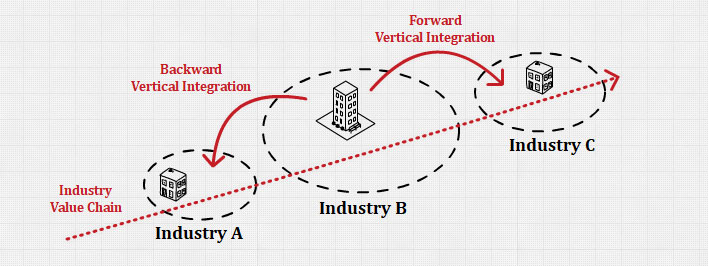Concentration Growth – Vertical Integration Strategy

What is a Vertical Integration Strategy?
Vertical integration is the degree to which a firm operates vertically in multiple locations on an industry value chain, from extracting raw materials to manufacturing to retailing.
Vertical integration can be achieved either by firms expanding their own internal operations or proceeding with external mergers or acquisitions with a company that is already in the industry.
Vertical integration strategy is a corporate-level strategy that involves a company entering new industries and take over functions previously provided by a supplier or by a distributor to increase its long-run profitability.
Each stage of the value-added chain is a separate industry in which many different companies may be competing. Within each industry, every company has a value chain composed of the value chain functions. In other words, for a value chain that runs across industries, embedded within it are the value chains of companies within each industry.
Reasons to Use This Strategy
Vertical integration strategy helps firms gain a better competitive position against their suppliers and distributors.
Firms entering the domain of a supplier or distributor can reduce or eliminate the leverage that the supplier or distributor has over the firms. This strategy can be very attractive when the suppliers and/or distributors have too much power over the firms and are becoming increasingly profitable at the firm’s expense.
Vertical integration strategy help firms add value to their products and/or services by increasing their product’s differentiation and/or reducing the costs of making them.
Firms can use this strategy to get involved in new portions of the value chain, which means access to new industries. In effect, firms can grow by making their own supplies and by distributing their own products.
From here firms can effectively find new ways to add value to the core products it makes and sells, reduce costs, gain control over scarce resources, guarantee the quality of input, or obtain access to potential customers. This can result in the maximization of long-run profitability.
Risks of Vertical Integration Strategy
Unknown industries: For firms facilitating a vertical integration strategy, venturing into new portions of the value chain can take them into very different businesses. Not knowing the industries introduces a high level of risk to the firms.
Complacency: Vertical integration can also create complacency. As such, the purchased company does not need to worry about doing a good job because the purchasing company is guaranteed to use the products and/or services. Some companies try to avoid this problem by forcing their subsidiary to compete with outside suppliers, but this undermines the reason for purchasing the subsidiary in the first place.
Advantages of Vertical Integration

A company pursues vertical integration to strengthen its competitive position in its original or core business.
There are 3 main reasons for pursuing a vertical integration strategy. It (1) enables the company to build barriers to new competition, (2) facilitates investments in efficiency-enhancing specialized assets, and (3) protects product quality.
Building Barriers to Entry
By vertically integrating backward to gain control over the source of critical inputs or by vertically integrating forward to gain control over distribution channels, a company can build barriers to new entry into its industry.
To the extent that this strategy is effective, it limits competition in the company’s industry, thereby enabling the company to charge a higher price and make greater profits than it could otherwise.
Facilitating Investments in Specialized Assets
A specialized asset maybe a piece of equipment used to make only one kind of product, or it may be the know-how or skills that a person or company has acquired through training and experience.
Companies invest in specialized assets because these assets allow them to lower the costs of value creation and/or to better differentiate their products from those of competitors. Thus having specialized assets can be the basis for achieving a competitive advantage at the business level.
A company has to vertically integrate and invest in the specialized assets itself because it may be very difficult to persuade other companies in adjacent stages of the value chain to undertake investments in specialized assets. Thus, in order to achieve a competitive advantage, one company may find that their best solution is to make investments in specialized assets themselves.
Protecting Product Quality
By protecting product quality, vertical integration enables a company to become a differentiated player in its core business.
Disadvantages of Vertical Integration

Vertical integration can result in some major disadvantages.
In general, vertical integration may reduce profitability if (1) a lack of cost-cutting incentive on the part of a company-owned supplier increases operating costs, or if (2) the inability to change its technology quickly results in lower quality and reduced differentiation.
Captive Buyers Phenomenon
Even though it is often undertaken to reduce production costs, vertical integration may actually increase costs when a company has to purchase high-cost inputs from company-owned suppliers despite the existence of low-cost external sources of supply.
Frequently, the operating costs of company-owned suppliers become higher than those of outside, independent suppliers when their managers know that they can always sell their components to the company’s assembly divisions—that are captive buyers. Because they do not have to compete for orders, company suppliers have less incentive to be efficient and find ways to reduce operating costs.
Managers of the supply divisions may be tempted to pass on any cost increases to other company divisions in the form of higher prices for components, rather than looking for ways to lower costs. This problem is far less serious when the company pursues taper, rather than full, integration.
Technology Inadaptability
Another problem is that when technology is changing rapidly, a strategy of vertical integration often ties a company into old, obsolescent, high-cost technology. In general, because a company has to develop value chain functions in each industry stage in which it operates, any significant changes in the environment of each industry, such as major changes in technology, can put its investment at risk. The more industries in which a company operates, the more risk it incurs.
Vertical Integration vs. Vertical Disintegration

If operating costs rise faster, over time than the value being created in a particular industry, companies will vertically disintegrate and exit the industries that are now unprofitable. Thus, there is a limit to how much a strategy of vertical integration can increase a company’s long-run profitability.
In general, not all vertical integration opportunities have the same potential for value creation. A company should pursue vertical integration only if the extra value created by entering a new industry in the value chain exceeds the extra costs involved in managing its new operations when it decides to perform additional upstream or downstream value creation activities.
Therefore, firms will first vertically integrate into those industry stages that will realize the most value at the least cost. Then, when the extra value created by entering each new industry falls and the costs of managing exchanges along with the industry value chain increase, firms can stop the vertical integration process.
Vertical Integration vs. Outsourcing

Under certain circumstances, companies can realize the advantages of vertical integration without experiencing its disadvantages and problems, by entering into cooperative outsourcing relationships with suppliers or distributors. Thus, the firms can make agreements with specialized suppliers or distributors to perform specific upstream or downstream activities on their behalf.
In general, outsourcing can help companies realize the gains associated with vertical integration if they enter into a long-term relationship of strategic alliances with their partners because trust and goodwill build up between them over time. In a short-term contract, it is often unable to realize the gains because outsourcing partners have little incentive to take the long view and find ways to help the companies reduce costs or improve product features or quality.
Vertical integration is generally more efficient than contracting for goods and services in the marketplace as transaction costs are usually too great. However, as the firm gets larger, the costs of internal transactions may exceed the cost of purchasing goods and services externally. Therefore, depending on the situation, outsourcing and vertical integration may triumph over one another.
Types of Vertical Integration

Backward Vertical Integration
Backward integration is a vertical integration strategy of seeking ownership, assuming functions or increased control of a firm’s suppliers.
Thus, a backward vertical integration strategy involves a firm moving back along the value chain and entering a supplier’s business.
There are several reasons why firms use backward vertical integration.
First, some firms use this strategy when they concern that a supplier has too much power over them, and are earning benefits on their expenses.
Second, this strategy can be especially appropriate when a firm’s current suppliers are unreliable, too costly, or cannot meet the firm’s needs.
Third, firms may use backward integration to minimize resource acquisition costs and inefficient operations. This can keep and improve the firm’s competitive advantage.
There are 7 guidelines for when backward integration may be an especially effective strategy.
They are as follows: (1) When an organization’s present suppliers are especially expensive, or unreliable, or incapable of meeting the firm’s needs for parts, components, assemblies, or raw materials; (2) When the number of suppliers is small and the number of competitors is large; (3) When an organization competes in an industry that is growing rapidly; (4) When an organization has both capital and human resources to manage the new business of supplying its own raw materials; (5) When the advantages of stable prices are particularly important; (6) When present supplies have high-profit margins, which suggests that the business of supplying products or services in the given industry is a worthwhile venture; and (7) When an organization needs to quickly acquire a needed resource.
Although backward integration is often more profitable than forward integration because of low margins in retailing, it can reduce the organization’s strategic flexibility, as expensive assets might be hard to sell and create barriers for an exit strategy.
Forward Vertical Integration
Forward integration is a vertical integration strategy of firms moving further up the value chain to enter distributor’s business, gain ownership, assume functions, or increase control over distributors or retailers.
With a forward vertical integration strategy, firms can (1) neutralize the effect of power buyers, and (2) gain more control over product distribution, thus keep and improve their competitive advantage.
There are 6 guidelines that indicate when forward integration may be an especially effective strategy.
They are as follows: (1) When an organization’s present distributors are especially expensive, or unreliable, or incapable of meeting the firm’s distribution needs; (2) When the availability of quality distributors is so limited as to offer a competitive advantage to those firms that integrate forward; (3) When an organization competes in an industry that is growing and is expected to continue to grow markedly; (4) When an organization has both the capital and human resources needed to manage the new business of distributing its own products; (5) When the advantages of stable production are particularly high; and (6) When present distributors or retailers have high-profit margins.
Full Vertical Integration
Full integration is where a firm internally makes all of its key suppliers and completely control its distributors.
Thus, a company pursues full integration when it produces all of a particular input needed for its processes or when it disposes of all its output through its own operations.
If the organization does not want full vertical integration, it may select either taper integration or quasi-integration strategies.
Taper Vertical Integration
Taper integration occurs when a company buys some components from independent suppliers and some from company-owned suppliers, or when it sells some of its output through independent retailers and some through company-owned outlets.
When a company pursues taper integration, company-owned suppliers have to compete with independent suppliers. This gives managers a strong incentive to reduce costs. If they do not do so, a company might close down or sell off its component operations.
Backward taper integration, or concurrent sourcing, is where a firm internally produces less than half of its own requirements and purchases the rest from outside suppliers.
For forward taper integration, a firm sells part of its goods and services through company-owned stores and another half through general wholesalers.
Quasi Vertical Integration
Quasi-integration is where a firm does not make any key supplies but purchases those from outside suppliers that are under partial control.
This is where the company wants to guarantee access to needed supplies, new products, technologies, and distribution channels but may not want to purchase them outright from a supplier or a distributor.
Resources
Further Reading
- Vertical Integration (investopedia.com)
- Vertical Integration Definition (boycewire.com)
- Horizontal vs. Vertical Integration: What’s the Difference? (investopedia.com)
- Vertical Integration (strategicmanagementinsight.com)
- Vertical integration and horizontal integration (mbacrystalball.com)
- What is Vertical Integration (thebalance.com)
- Vertical Integration Strategy: Advantages, Disadvantages, Types (iedunote.com)
- Vertical Integration (quickmba.com)
- Vertical Integration Examples that Show How the Consumer World is Evolving (advergize.com)
Even More Reading
Related Concepts
References
- Hill, C. W. L., & Jones, G. R. (2011). Essentials of Strategic Management (Available Titles CourseMate) (3rd ed.). Cengage Learning.
- Wheelen, T. L. (2021). Strategic Management and Business Policy: Toward Global Sustainability 13th (thirteenth) edition Text Only. Prentice Hall.